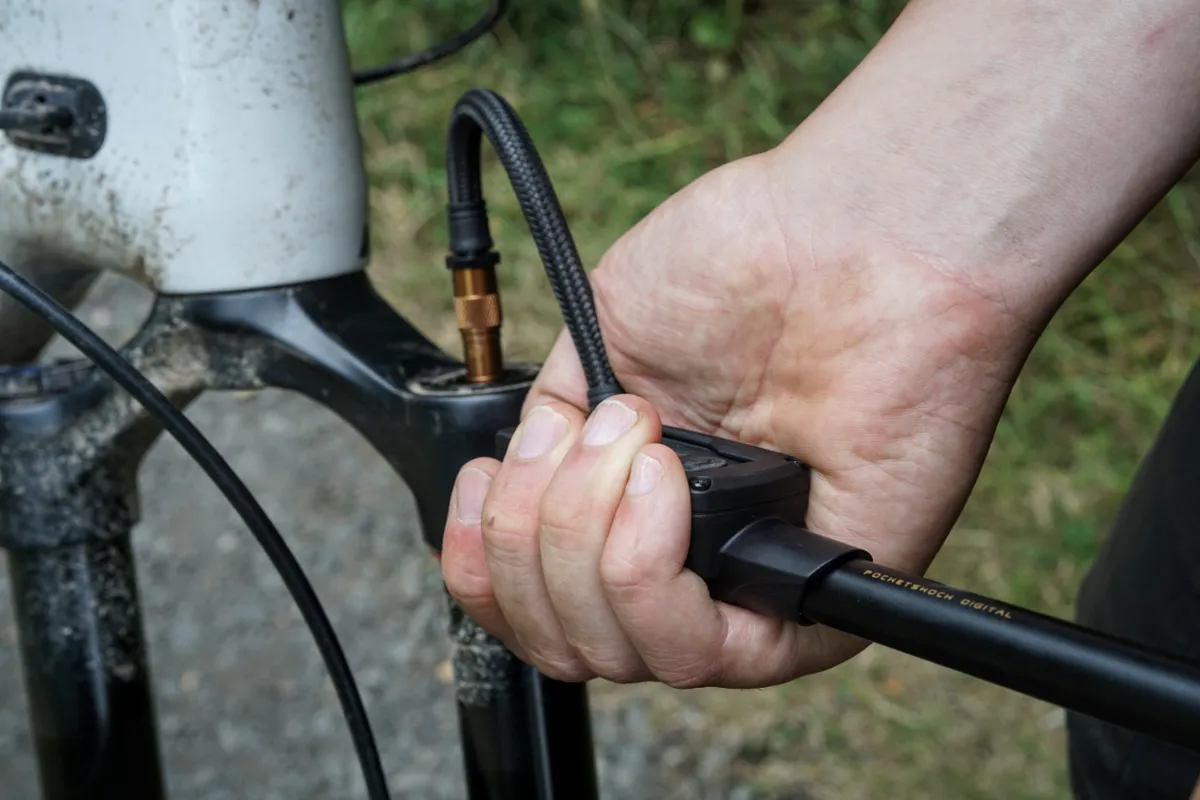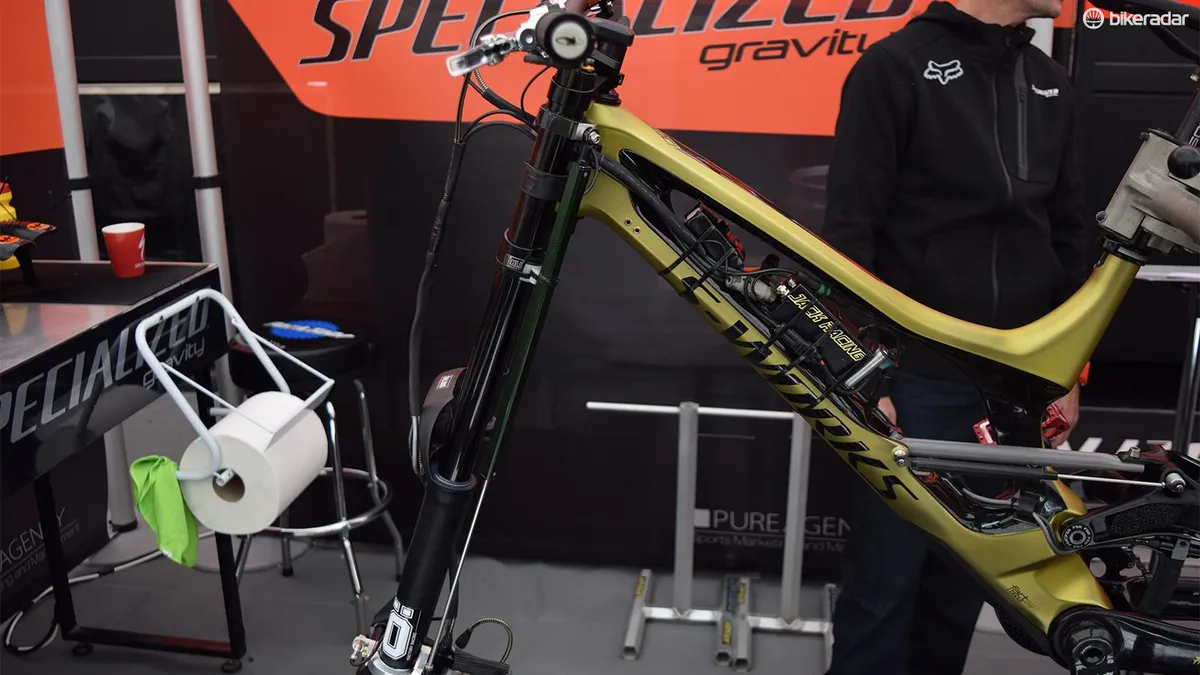No matter how much you upgrade or tune it, your bike is not going to look or ride exactly like the ones ridden by the pros. But it's not solely down to big budgets – there are some hidden reasons that pros' bikes are faster than those you can buy.
While consumer components aren’t far behind in product cycles, pro bikes feature a few significant differences that set them apart from their showroom counterparts, some of which aren’t easy to spot.
These differences are all in the name of speed, and while some might not be realistic to adopt for your own bike, they’re still fascinating to study.
Here are five pro bike setup tips I’ve spotted while covering the hottest tech from events including the downhill World Championships and Red Bull Hardline.
Suspension setup

Suspension has a huge influence on the way a bike rides, and pro riders need theirs to be set up precisely for their needs.
Most of us could only dream of having suspension dialled for the trail we’re riding, but professional riders have access to technical data enabling them to set up their bikes for each specific race track.
Their suspension experts not only set up and tune the suspension, but also customise parts.
Expert tuners will focus on minimising friction by modifying parts, perhaps throwing a few dust seals in the bin and using secret lubricants.
Working alongside suspension engineers, professional riders are able to test specific setups for extended periods to see which offer the best traction and impact absorption on the trail.
Riders’ mechanics swap out coils, change air-can tunes and use telematic data to decipher where more grip can be achieved.
Air and coil-sprung shocks each have advantages and disadvantages. Coil shocks have resilience against heat build-up and demonstrate lower friction than air shocks. However, air shocks enable riders to tune the spring progression curve with volume spacers and make quick spring-rate changes.
Spring rates on coil shocks can be difficult and expensive to fine-tune because the entire spring needs to be replaced each time a stiffer or softer setup is needed.
However, being a sponsored pro rider is not always as easy as it seems. Professional riders are often contractually obliged to use only products supplied by their sponsors.
It’s always worth looking at what privateer World Cup racers are running. These ‘satellite’ riders have the pick of the products if they have to shell out their own money on a setup. If they’ve chosen to spend their cash on a product, it’s probably the best you can get.
Lead weights

Something most riders try to avoid adding to their bikes is weight.
However, many pro downhill racers add strategically positioned weights to their bikes to improve the ratio of sprung to unsprung weight.
Unsprung mass is the weight of the components that move with undulations of the ground and aren’t supported by the suspension. Components that make up unsprung mass include the wheels, fork lowers, brake discs and calipers, and the derailleur and cassette.
Conversely, the sprung mass of the bike is any weight isolated from the ground by suspension, consisting of the front triangle of the frame, the cranks and pedals, the cockpit and the fork uppers.
Increasing the ratio of sprung to unsprung weight makes the suspension work more effectively, increasing traction and reducing rider fatigue. If you’ve ridden an ebike, you'll have noticed the stability and smoother ride on rough terrain, owing to the extra sprung mass from the weight of the battery and motor.
Rider weight doesn’t affect this ratio, because the rider is not connected rigidly to the bike. Riders support their weight using their muscles to absorb inputs transmitted to them through the bike.

Weights are usually added to bikes by the bottom bracket to keep the centre of gravity low, aiding stability. Riders also add weights around the head tube and handlebar area to reduce feedback through the fork.
There is a gravitational effect of adding more weight to your bike. Many people think a heavier bike will gather more momentum when rolling downhill. However, this isn’t a soapbox derby: extra weight slows the rider down when pedalling.
Tuned-mass dampers are a new addition to the downhill mountain bike circuit, with riders adding a weight to their bikes, which is suspended between springs in a tube. Essentially, the tuned-mass damper is designed to reduce vibration and increase traction for the rider.
Recreational riders may wince at the thought of adding weights to their bike, but if you’re downhill racing, taping extra weight to your down tube may be a cheap way of finding extra time on steep, rough tracks.
Data acquisition

One of the main differences between professional and amateur bikes is the level of research that goes into setting them up.
Most amateur riders set their bikes up using the manufacturer's recommendations, whereas pro bikes can use telematic sensors to collect data.

Saracen mechanics in charge of the pre-production prototype Myst DH bike, with its six-bar linkage, were proud of how well the data-acquisition hardware was hidden in the frame.
Saracen’s efforts in designing parts of its prototype frame around data-acquisition systems show how important it is in modern downhill racing.
Sensors on the fork and shock give mechanics insights into suspension setup, with riders running practice laps as software records every movement.
Brake pressure is monitored, telling riders where the wheels are locked up due to heavy braking and how this is affecting the suspension’s action. Consumer versions of such brake sensors include BrakeAce's caliper-mounted examples.
The system can even help riders work out the best braking points using GPS data and brake-force data.
Quarq’s ShockWiz is available to buy and can digitally monitor and advise on your setup, while Mondraker’s MIND is an integrated suspension telemetry system designed to simplify suspension setup. It uses patented technology that integrates telemetry recording hardware into a bike's steerer tube.
If you’re really serious, you could shell out €1,749 for a BYB Tech telemetry setup.
Prototype tech

While you may have spent thousands of pounds on the latest kit for your bike, you’ll always be behind the professionals and their prototype tech.
The biggest difference between professional and off-the-shelf bikes is the prototype tech reserved for riders at the top end.
Downhill racing is regarded as the 'Formula One' of mountain biking, where the latest innovations are put to the test.
Loic Bruni’s prototype Specialized Demo DH bike had cables and brightly coloured buttons on the handlebar. We can speculate they may be to do with locking out the suspension on pedal-heavy parts of the track.
Pivot developed the new Firebird DH bike with the help of Bernard Kerr. The prototype bike featured a lugged carbon frame not dissimilar from the Atherton Bikes AM series.
This enables changes to be made to a new frame quickly, during the development process without spending time creating a new mould for an entire frame. It means riders can change geometry at will.
There is little you can do to get your hands on prototype parts, other than making your own, but bike component manufacturers are usually quick to integrate new tech from the race circuit into their products.
Quiet bikes are fast bikes

When you're hurtling down a track at full speed, even the smallest thing can distract your attention and cause you to go off line or crash.
Most pros have their own mechanic with a back catalogue of secret hacks to make each bike as quiet as possible.
It’s always worth addressing the simple tasks to quieten a bike down before diving into more convoluted methods.
Impeccable maintenance, lubing chains and making sure grease-packed fresh bearings are fitted can prevent unwanted rattles and squeaks.
There are many strategies mechanics implement to quieten bikes: chains striking frames and chain guides can be a big source of noise, so extended chainstay protectors and a liberal use of mastic tape is a great way to dampen any noise.
We’ve also seen some handy hacks with the loopy side of Velcro being stuck on chain guides and other areas of chain contact to keep rattles at bay.
These mods can be time-consuming, but it’s worth it because a quiet bike is a fast bike.




